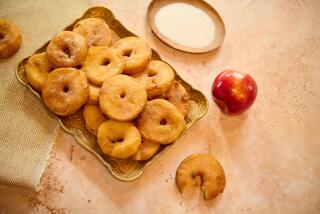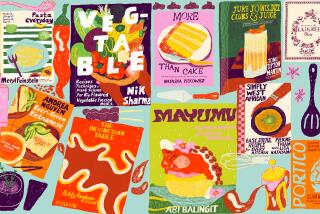The holiday where oil is the star
- Share via
WHEN Hanukkah begins Friday night, all around the world Jews will be preparing dishes that represent the holiday perfectly. The Ashkenazim will be frying potato latkes. In Israel they’ll be making sufganiyot, the little jam-filled doughnuts. Italian Jews will deep-fry pieces of chicken dipped in batter. The Sephardim will eat fritters in syrup, which are variously called zalabia, bimwellos, loukoumades, sfenj or yoyos.
It’s all about the oil, of course.
Each dish is a way of commemorating the miracle of the oil that was enough to burn only for one day but instead burned for eight as the Jews set about restoring the temple at Jerusalem in a time of war more than 2,000 years ago.
In Egypt, where I grew up, it was the zalabia that reigned at Hanukkah, and the fritters soaked in a sweet, perfumed syrup are still close to my heart, because they are a reminder of my parents, my brothers and grandparents, my cousins, uncles and aunts and of our home in Cairo. We could buy zalabia from street vendors year-round, but at Hanukkah they took on a symbolic significance and Awad, our cook, made masses of them, enough to serve all the visitors who called to celebrate.
Over the years I’ve learned to make and to love all of those other fried holiday dishes too. This is all simple food, representing very old traditions, not the gourmet creations of chefs who add trimmings for the sake of originality. And I think these dishes are all the more delicious for it.
The simplest, of course, is the potato latke, the golden pancake made with just eggs and grated potatoes squeezed dry of their starchy juices. They should be made just before eating, so they are crisp on the outside and soft inside. Many versions add ingredients such as onion and garlic, but I prefer the original basic dish, with the pure taste of potato.
Likewise, the pollo fritto, the Tuscan dish of tender, juicy chicken, pieces is sharpened with a simple lemon marinade and then rolled in flour and beaten egg. The scrumptious apple latkes, made with fruit macerated in brandy, are dipped in an ever so light batter.
And of course, there are the zalabia.
Some years ago, I was experimenting with the zalabia recipe in London when my grandson, then 7, happened to call. The following day Cesar came home from school with a drawing representing me, very tiny in the middle of a huge page, surrounded by bowls filled with little balls -- on the kitchen table, on the dresser, on the floor, everywhere. I had made so many batches while trying out different proportions of flour and water in order to get them to come out perfectly round, which they never did.
And really, the shape didn’t matter. They were incredibly light and puffy, and gorged in aromatic syrup. They were, in the end, another miracle, the culinary triumph of hot oil.
*
Chicken pieces fried in batter (pollo fritto)
Total time: 20 minutes, plus 1 hour standing
Servings: 2-4
1 boneless, skinless chicken breast, about 1/2 pound
Juice of 1 lemon
Salt, pepper
Flour
1 egg, lightly beaten
Canola oil, for frying
1. Cut the chicken into 2-inch pieces. Marinate for 1 hour in the lemon juice and a little salt and pepper. Roll the pieces in flour, then in the beaten egg (prepare a soup plate of each, and the chicken pieces can all be in at the same time).
2. Heat 1 inch of oil in a heavy pot to 350 degrees. Deep-fry the chicken until golden, about 3 minutes. If the oil is too hot, the batter will burn before the chicken is done. If you want to make a large quantity, you may reheat the chicken in the oven.
Each of 4 servings: 262 calories; 131 mg. sodium; 100 mg. cholesterol; 17 grams fat; 2 grams saturated fat; 6 grams carbohydrates; 20 grams protein; 0.24 gram fiber.
Variation: The Tunisian “Livornese” version -- poulet en beignets -- is a chicken cut in small pieces marinated 1 hour in a mixture of 3 tablespoons of extra-virgin olive oil, the juice of 1 lemon, 2 crushed garlic cloves, 3 tablespoons finely chopped Italian parsley, salt and pepper, then dipped in a batter made with 1/3 cup flour beaten with 1 egg and a little water -- just enough to obtain a light cream -- plus salt and pepper. Deep-fry about 3 minutes in oil heated to 350 degrees, and serve with lemon quarters.
*
Apple latkes
Total time: 40 minutes, plus 1 hour standing
Servings: 4
Note: This is a specialty of Hanukkah. Of several fritters that I have tried, this one is the most scrumptious, because the apples are macerated in brandy, which gives them a most wonderful flavor, and the batter is very light. You can also use beer or milk instead of water for the batter.
4 tart or sweet apples
2-3 tablespoons sugar
3 tablespoons brandy, dark rum or fruit liqueur
2 eggs, separated
2 tablespoons canola oil
A good pinch of salt
1 cup flour
1/2 cup water
Vegetable oil for frying, preferably sunflower
Superfine sugar, for sprinkling
1. Core and peel the apples and cut each into 4 thick slices. Place them in a shallow dish with the sugar and brandy, rum or liqueur, and turn them so that they are well coated. Leave for at least 1 hour, turning the slices over occasionally so that they absorb the spirit.
2. For the batter, beat the yolks with the oil and salt, then stir in the flour and mix well. Now beat in the water gradually and vigorously, squashing any lumps. The batter will be thick and sticky. Let stand for an hour.
3. Beat the egg whites until stiff, 3 to 4 minutes. Fold one-fourth of the egg whites into the batter, then fold in the rest of the whites.
4. Heat at least 3/4 inch of oil in a large frying pan to 375 degrees. Pat dry the apple slices (so the batter will stick to them). Dip the slices in the batter -- about 5 at a time -- making sure they are well covered. Lift each one out carefully and lower it into the hot oil. The oil must be sizzling but not too hot, or the fritters will brown before the apple is soft inside.
5. Fry in batches, and turn the slices over to brown both sides, about 1 1/2 to 2 minutes a side. Lift out the slices with a slotted spatula and drain on paper towels before serving. Pass the superfine sugar for everyone to sprinkle on.
Each serving: 372 calories; 91 mg. sodium; 103 mg. cholesterol; 17 grams fat; 2 grams saturated fat; 47 grams carbohydrates; 6 grams protein; 2.94 grams fiber.
*
Fritters in syrup (zalabia)
Total time: 1 1/2 hours, plus 2 hours standing
Servings: 16-18 servings (96 fritters)
Sugar syrup
5 cups sugar
2 cups water
Juice of 1/2 lemon
1 tablespoon rose or orange blossom water
1. Place the sugar, water and lemon juice in a saucepan and simmer until it is thick enough to coat a spoon, about 15 minutes. Add the rose or orange blossom water and simmer a few seconds longer, then remove from the heat and let come to room temperature. Cover while you make the fritters.
Batter
2 teaspoons active dry yeast
1 teaspoon sugar
1/2 cup hot water (120-130 degrees), plus 2 1/2 cups warm water, divided
3 1/2 cups flour
1/2 teaspoon salt
Oil, for frying
1. Dissolve the yeast and sugar in the half cup of hot water and let stand until it froths, 10 to 15 minutes. Place the flour in a large bowl, mix in the yeast liquid and the salt, then gradually stir in the remaining 2 1/2 cups water and beat vigorously on medium-high speed with an electric mixer until smooth and elastic, about 10 minutes. Cover with a dish towel and leave to rise in a warm place for 1 hour, then beat the batter another 10 minutes, and let it rise again for 30 minutes. Beat the batter again for 10 minutes, then let it rest a final time for 30 minutes.
2. Make the fritters in batches, using 2 skillets at once, if you prefer, to speed up the frying: Fill a deep, nonstick skillet a little more than half full with oil and heat to 375 degrees. Drop little balls of batter by the tablespoon into the oil; you may find it easiest if you dip the spoon in oil first, then fill it with batter using another spoon so that the batter rolls off easily. Wipe the spoon with a damp paper towel after making each ball. Fry the balls, turning them with a slotted spoon to brown them all over, until crisp, golden and puffed, about 7 minutes. Do not crowd the skillet; 6 at a time is a good number. The batter is light and produces irregular, rather than perfectly round, shapes. If the oil is not hot enough to begin with, the batter tends to flatten out.
3. Lift the fritters out with a slotted spoon, drain on paper towels and dip them in the cold syrup for a few seconds (if you prefer, you may leave them longer to soak up syrup). Set them on a wire rack with wax paper underneath to drain. They are at their best hot but are also good cold.
Each of 18 servings: 141 calories; 66 mg. sodium; 0 cholesterol; 5 grams fat; 0 saturated fat; 22 grams carbohydrates; 2 grams protein; 0.70 gram fiber.
Variation: Instead of dipping the fritters in a sugar syrup, pour a honey syrup over them; make it by heating honey with about half its volume of water. You can also sprinkle the fritters instead with powdered sugar and cinnamon.
*
Potato latkes
Total time: 40 minutes
Servings: 6
Note: You may add pepper, chopped parsley and finely chopped onion to the egg and potato mixture.
2 pounds potatoes
2 eggs
Salt
Oil, for frying
1. Peel and finely grate the potatoes. Put them straight into cold water, then drain and squeeze them as dry as you can by pressing them with your hands in a colander. This is to remove the starchy liquid, which could make the latkes soggy.
2. Beat the eggs lightly with salt to taste, add to the potatoes and stir well. Film the bottom of a skillet with oil and heat over medium heat. Take serving-spoonfuls or as much as one-fourth cup of the mixture and drop into the hot oil. Flatten a little and lower the heat so that the latkes cook through evenly. When one side is brown, turn over and brown the other. Lift out and serve very hot.
Each serving: 179 calories; 222 mg. sodium; 69 mg. cholesterol; 6 grams fat; 1 gram saturated fat; 27 grams carbohydrates; 4 grams protein; 2.38 grams fiber.
*


